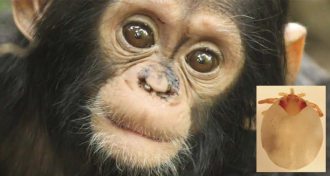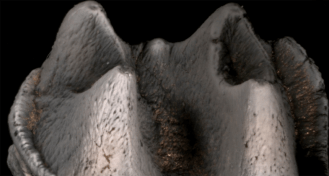Search Results for: Vertebrates
Skip to resultsCan’t find what you’re looking for? Visit our FAQ page.
1,539 results for: Vertebrates
-
 Health & Medicine
Health & MedicineNow Hear This
Genetics research, work with stem cells, and studies of the inner ear's delicate architecture suggest that it might be possible to restore cells pivotal to hearing.
-
 Paleontology
PaleontologyAmphibious Ancestors
Newly discovered fossils from Greenland, as well as a reexamination of those of previously known creatures, are providing researchers with additional insights into ancient vertebrates' move from water to land.
By Sid Perkins -
 Paleontology
PaleontologyBone Hunt
Science News reporter Sid Perkins recounts the trials and tribulations of digging for dinosaurs in central Montana.
By Sid Perkins -
 Humans
HumansScience News of the Year 2006
A review of important scientific achievements reported in Science News during the year 2006.
By Science News -

19923
I have heard that whales evolved millions of years ago into their present form, including their very large brains. We humans must be relatively recent in terms of our brain structures. Are there data concerning evolutionary development in whales? Matthew KabriskyDayton, Ohio “Learning to Listen: How some vertebrates evolved biological sonar” (SN: 5/14/05, p. 314) […]
By Science News -
 Health & Medicine
Health & MedicineYoung Women Don’t Bone Up on Soy
Among the many reported nutritional benefits of diets rich in soy is a strengthening of bone in postmenopausal women. For these Golden Girls, who face an increasing risk of osteoporosis, soy-based foods can provide much-needed assistance in limiting the inevitable loss of bone. Although soybeans are best known for their oil, their protein is also […]
By Janet Raloff -
 Health & Medicine
Health & MedicineVegetable Soup Fights Cell Damage
A study in which volunteers ate vegetable soup every day for two weeks points to benefits of vitamin C beyond its role as an antioxidant.
-
 Animals
AnimalsBuilt for Blurs: Jellyfish have great eyes that can’t focus
Eight of a box jellyfish's eyes have superb lenses, but their structure prevents them from focusing sharply.
By Susan Milius -

Vertebrates, insects share the stress
A key protein involved in animals' physiological responses to stress has carried out the same function since before any organism developed a backbone.
By Ben Harder -
 Animals
AnimalsWing Ding: Bird rubs feathers for cricketlike song
Scientists say that they have found the first vertebrate to make its courtship music in the same way as a cricket does.
By Susan Milius -
 Animals
AnimalsHiding up your nose is a clever strategy for ticks
Found hiding in the noses of Ugandan chimps, a new tick species hitchhiked its way to America in a researcher's nose.
-
 Paleontology
PaleontologyGiant platypus tooth found
A fossil molar found in Australia reveals a previously unknown extinct species of the mammal.